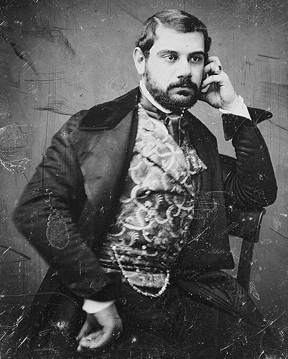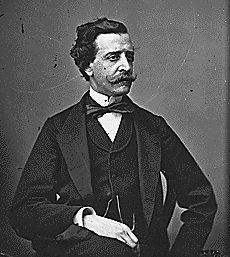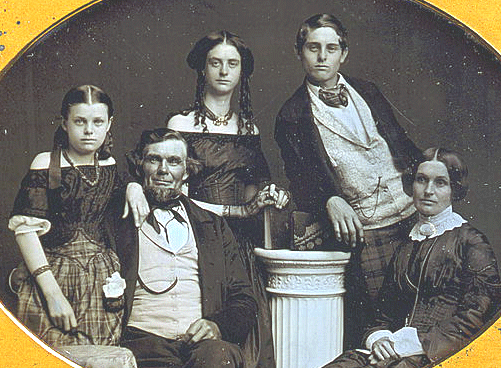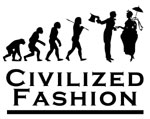Men's Portrait Gallery
1850
In contrast to the 1840's, the 1850's reflected a marked preference for bolder styling particulary seen in frock coats with wider lapels and looser cuts. Waistcoats became fancier with bold patterns and metal buttons. In the early part of the decade, gentlemen wore extravagant, heavily starched, assymetrically tied cravats, which subsided later in the decade to reflect softer styling. At the beginning of the decade many gentlemen wore their hair parted on the side styled with an extreme frontal wave on top, but once again this subsided toward the end of the decade.
To recreate this look, you can choose from any of our Victorian Frock Coats, and pair with a dress vest. The look can be finished off with a Puff Tie or an Ascot.

Family Portrait
With the (apparently) three generations represented in this photo, it is easy to see how styles were interpreted differently based on age. The young gentleman on the right has a wonderful example of the strongly horizontal cravat that was considered stylish. While the gentleman standing on the left reflects a more conservative, centered tied style. All three display low cut vests which display their fine white dress shirts.

Opera Singer
This opera singer highlights the sartorial preferences of stylish gentlemen during the late 1850's. Most notable is his fancy silk vest with a bold pattern and metal buttons. This reflected the general exuberance in clothing during the latter part of this decade. His frock coat has a wide velvet collar and turned up sleeves. His hairstyle is typical of the time with a high part and brushed smoothly down. His cravat is tied as a soft silk ascot.

Victorian Businessman
This conservative businessman has the fashionable, highly starched cravat that was common in the 1850's. Note the assymetric, very horizontal bow with the high collar above. His suit has a relatively loose cut through the arms and is the conservative black or dark brown common in that day. His outfit is very subdued, punctuated only by his pocketwatch chain.

Victorian Family
This family portrait shows an affluent family that has an appreciation for fine clothing. The gentleman in the fore wears a loose fitting frock coat with a finely patterned shawl collared vest. The younger gentleman's trousers reflect the popularity of checks and patterns common during the 1850's. Men often wore mismatched check patterns of different sizes and colors. This young man has a large fold down collar over a loosely tied cravat and a lovely, fancy shawl collared vest. Very dashing.
What did men wear in the 1850s?
Men in the 1850s experienced a revolution in fashion as technological advancements like Singer's foot-powered sewing machine made clothing more accessible across social classes. Their typical ensemble evolved from a narrow, form-fitting silhouette early in the decade to a boxier, more comfortable fit by mid-decade, featuring frock coats for formal occasions, sack coats for casual wear, colorful patterned vests, white shirts (increasingly with detachable collars), simpler neckties, and trousers that grew looser over time, all topped with the ever-present gentleman's topper for formal occasions.
What did upper class men wear in the 1850s?
Upper class men in the 1850s displayed their status through impeccably tailored garments that followed the latest fashions, including frock coats for day wear and tailcoats for evening occasions. Their evening attire was particularly distinctive, featuring black tailcoats over white shirts with pleated, stiffly starched bib fronts, white waistcoats, white stocks or cravats, black trousers, polished black leather shoes, and tall black silk top hats, sometimes complemented by fur-trimmed Chesterfield overcoats or thigh-length capes when attending high-society events.
What did working class men wear in the 1850s?
Working class men in the 1850s benefited from the democratization of fashion through ready-to-wear clothing, but their daily attire remained focused on durability and function. They typically wore ready-made loose shirts with plain band collars and half-button plackets in solid colors or stripes, tucked into pants and worn under vests or sometimes just with suspenders for outdoor work. Those engaged in heavy labor or agricultural work often wore the smock frock made from sturdy cotton or linen as a protective outer layer, while the sack coat became standard workingman's wear.
MORE Q&A
Is Historical Emporium's 1850s men's clothing good quality?
Historical Emporium offers period-appropriate reproductions that capture the transitional styles and innovations of 1850s men's fashion. Their well-crafted historical clothing includes authentic details like the evolving silhouettes of frock coats, morning coats, and the increasingly popular sack coats of the period. Historical Emporium's attention to historical accuracy in fabrics, patterns, and construction makes these garments valuable for reenactors, theatrical productions, collectors, and enthusiasts interested in this pivotal decade when modern men's fashion began taking shape amid technological revolutions in clothing production.
What coats did men wear in the 1850s?
Men in the 1850s wore four main coat styles: the frock coat (the decade's defining garment for daytime formal wear, cut straighter with a waistline seam and falling to knee-length); the morning coat (gaining acceptance as an alternative to the frock coat, with an opening sloping gently to the hem); the sack coat (a more relaxed, hip-length style without a waist seam, popular for casual occasions and workwear); and the tailcoat (increasingly restricted to evening formal wear and full dress occasions).
What hats did men wear in the 1850s?
In the 1850s, men's top hats reached new heights—literally growing taller as the decade progressed toward the "stovepipe" styles of the early 1860s, and typically made from glossy black silk for formal occasions. For daytime wear, men had several alternatives including the felt wide-awake hat (with its tall crown and wide, stiff brim), caps for young men and boys, traveling caps with earflaps, and the newly introduced stiff felt bowler or derby hat, which would eventually replace the top hat as standard headgear in later decades.
What shirts did men wear in the 1850s?
Men's shirts in the 1850s remained predominantly white for both day and evening wear, though the rise of ready-made clothing introduced more variety including colored stripes, checks, and small patterns. A significant innovation of the decade was the introduction of both attached and detachable collars and cuffs, making laundering easier, while collar height decreased from previous decades, with turned-down collars becoming common by the late 1850s.
MORE Q&A
What pants did men wear in the 1850s?
Trousers in the 1850s evolved from the slim styles of the early decade to progressively looser fits as the years passed. Men had two main options: straight-cut legs or those tapering to the ankle, with a significant change in construction as pants now featured a single button fly at center front rather than the fall front flap of earlier periods. The fashionable 1850s trouser embraced a wide array of patterns and colors including plaids, checks, stripes, and lighter hues, rarely matching the coat or vest.
What vests did men wear in the 1850s?
The 1850s saw a resurgence of double-breasted vests with widening lapels and rising necklines to accommodate higher-placed ties, while single-breasted styles remained popular as well. Technological advancements in textile production, improved loom technology, and the introduction of aniline dyes in 1856 transformed vests into vibrant fashion statements with intricately woven fabrics, glossy silks, and a vast array of colors, creating a striking contrast with the increasingly somber coats of the period.
How did men style their hair in the 1850s?
Men's hairstyles in the 1850s reflected a polished appearance, with many using macassar oil to style their hair long on top and combed into a high wave at the front—a fashion that peaked mid-decade and led to the widespread use of "antimacassars" (protective cloths on furniture) to prevent oil stains. As the decade drew to a close, hair trends shifted toward parted and slicked-back styles, with length reaching the collar and covering the ears, while facial hair evolved from clean-shaven faces to beards along the jawline or narrow goatees.
What was unique about men's fashion in the 1850s?
The 1850s represented a pivotal moment in men's fashion history due to technological innovations that democratized clothing. Singer's sewing machine (1851) dramatically reduced garment production time, while William Henry Perkin's accidental creation of the first synthetic dye (1856) introduced affordable vibrant fabrics. These advances, coupled with the expansion of ready-to-wear menswear (exemplified by Brooks Brothers in New York), narrowed the appearance gap between social classes. The decade also saw the introduction of specialized garments like smoking jackets for leisure wear and a gradual shift from the constrained silhouettes of previous decades to fuller, more comfortable styles.
Want to learn more? Visit our 1850s Mens Fashion Guide.










